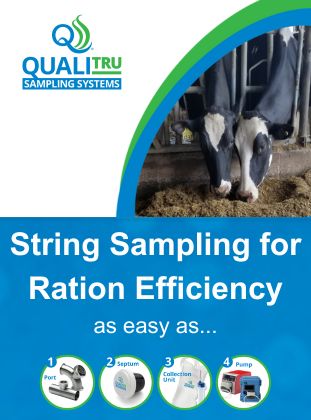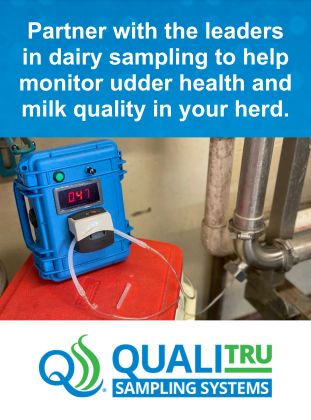Effect of maternal bovine appeasing substance on health and performance of pre-weaned dairy calves

Article courtesy of Fera Diagnostics and Biologicals Corporation.
This study aimed to evaluate the impacts of a maternal bo- vine appeasing substance (MBAS) administered to pre-weaned Holstein calves on their health and performance. In total, 410 calves individually allocated were enrolled (Treatment, n = 205; Control, n = 205). Treated calves received a topical application of MBAS to the nuchal skin (2.5 ml) and the skin above the muzzle (2.5 ml) at one day of age and then every 14 days until weaning at 60 days of life. An extra dose was applied when calves were moved from hutches to collective pens at approximately 100 days of age. Calves allocated to the control group did not receive any kind of treatment. MBAS reduced the incidence of diarrhea.
Among the several different pheromones that are produced by cattle, the appeasing pheromones play an important role in mitigating stress which can cause deleterious effects either in beef or dairy cattle. There are several events that can cause undesired stress to the animals within bovine production systems, such as weaning, vaccination, transport and exposure to a new environment. Therefore, exposure to stressors associated with cattle management is inevitable and strategies to alleviate the stress-induced responses are needed.The use of appeasing pheromone is considered an important strategy to enhance cattle welfare and productivity in the face of stressful procedures.
In the literature, the pheromone in question is described as maternal bovine appeasing substance (MBAS), and it has been reported in several studies that its topical application improved performance and reduced morbidity in beef cattle systems due to stress mitigation.
Materials and methods
The study was conducted in a commercial dairy farm located in upstate New York, milking approximately 5,000 dairy cows thrice daily. Immediately after parturition, calves were sepa- rated from their mothers and placed into a newborn pen bed- ded with dry wood shavings and heated with heating lamps during months with cold temperatures. All calves were fed approximately 4 L of pasteurized pooled colostrum within 5 hours of birth by an esophageal feeder (Oral Calf Feeder Bag with Probe, Jorvet). Once a day, calves were removed from the newborn pen, transported to the calf raising facilities and placed in individual calf hutches. The hutches were dis- tributed in 5 lanes containing 160 hutches each. Calves were fed milk twice daily and after the first week of life, solid feed began to be offered. The weaning process started at 50 days of calf age by reducing the amount of milk offered until the complete absence of milk at 60 days of age. After weaning, calves were maintained in the hutches for approximately 40 days and then moved to collective pens commingling 40 calves per pen.
Our study and that by Angeli et al. (2020) are the only studies to have reported mortality risk in preweaned dairy calves treated with MBAS.7 In their study, no differences were found in mortality between treated and control calves; however, their mortality risk was 3.6%, which was much lower than that in our study. This indicates that MBAS could potentially have an effect in reducing mortality in highly challenging systems, as observed in our study.
In the present study, greater body weights were observed in the treated calves 7 days after they were moved from the indi- vidual hutches to the collective pens. Birth weights were not measured in this study; therefore, it wasn’t possible to calculate ADG values for those calves. However, improvement in ADG has been reported previously in calves receiving MBAS. Another study revealed that both ADG and total feed intake were increased in beef calves receiving MBAS at weaning compared to control calves.8 These authors suggested that additional administration of MBAS, such as every 14 days as in the present study, would further extend its benefits on calf growth, not only because of the increase in the feed intake, but also because of the increase in feed efficiency. Similarly, the authors also indicated that MBAS administration at 14-day intervals improved performance of preweaning dairy calves.7 Corroborating these results, positive effects of MBAS have
Conclusions
This present study reveals the beneficial effects of administration of MBAS every 14 days in preweaned Holstein calves. Reduction in the incidence of diarrhea as well as mortality risk were observed in calves that received MBAS. Therefore, the use of MBAS during the pre weaning period can be a suitable strategy to improve health and performance of dairy calves.
*Leonardo Bringhenti,1 DVM, PhD; Eduardo Colombo,2 DVM, PhD (Candidate); Marjory X. Rodrigues,1 PhD; Reinaldo F. Cooke,2 DVM, PhD



